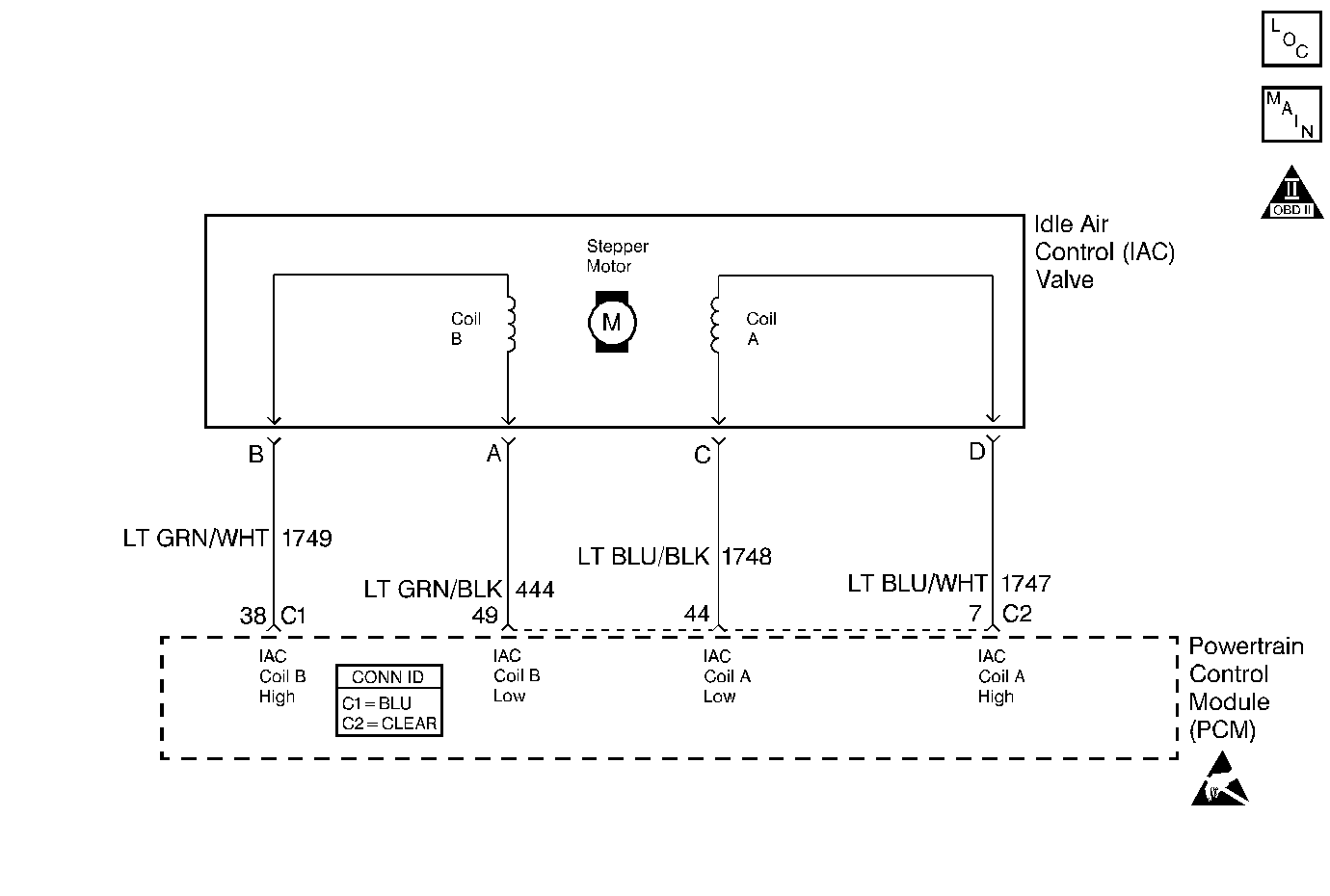
Circuit Description
The PCM controls engine idle speed by adjusting the position of the Idle Air Control (IAC) motor pintle. The IAC is a bi-directional motor driven by two coils. The PCM applies current to the IAC coils in steps (counts) to extend the IAC pintle into a passage in the throttle body to decrease air flow. The PCM reverses the current to retract the pintle, increasing air flow. This method allows highly accurate control of idle speed and quick response to changes in engine load. If the PCM detects a condition where too low of an idle speed is present and the PCM is unable to adjust idle speed by increasing the IAC counts, DTC P0506 will set indicating a problem with the idle control system.
Conditions for Running the DTC
| • | No active TP, ECT, MAP, IAT, MAF, CKP, sensor, EVAP, misfire, EGR, VSS, Fuel Trim, injector circuit, DTCs. |
| • | Engine Coolant Temperature is above 70°C (158°F). |
| • | The engine has been running for at least 2 minutes. |
| • | System voltage is between 9.0-16.0 volts. |
| • | Vehicle Speed is less than 3 mph. |
| • | Intake Air Temperature is above -18°C (0°F). |
| • | The throttle is closed |
| • | BARO above 65 kPa. |
| • | Engine run time is greater than 2 minutes. |
Conditions for Setting the DTC
- Engine Speed is 100 RPM or lower than Desired Idle.
- Above condition present for more than 15 seconds.
Action Taken When the DTC Sets
| • | The PCM illuminates the malfunction indicator lamp (MIL) on the second consecutive ignition cycle that the diagnostic runs and fails. |
| • | The PCM records the operating conditions at the time the diagnostic fails. The first time the diagnostic fails, the PCM stores this information in the Failure Records. If the diagnostic reports a failure on the second consecutive ignition cycle, the PCM records the operating conditions at the time of the failure. |
| • | The PCM writes the conditions to the Freeze Frame and updates the Failure Records. |
Conditions for Clearing the MIL/DTC
| • | The PCM will turn OFF the malfunction indicator lamp (MIL) during the third consecutive trip in which the diagnostic has run and passed. |
| • | The history DTC will clear after 40 consecutive warm-up cycles have occurred without a malfunction. |
| • | The DTC can be cleared by using a scan tool. |
Diagnostic Aids
Check for the following conditions:
Important: : Remove any debris from the connector surfaces before servicing a component. Inspect the connector gaskets when diagnosing or replacing a component. Ensure that the gaskets are installed correctly. The gaskets prevent contaminate intrusion.
| • | Poor terminal connection. |
| Inspect the harness connectors for backed out terminals, improper mating, broken locks, improperly formed or damaged terminals, and faulty terminal to wire connection. Use a corresponding mating terminal to test for proper tension. Refer to Intermittents and Poor Connections Diagnosis , and Connector Repairs Wiring Systems. |
| • | Damaged harness. |
| Inspect the wiring harness for damage. If the harness appears to be OK, observe the sensor display on the scan tool while moving connectors and wiring harnesses related to the sensor. A change in the sensor display may indicate the location of the fault. Refer to Wiring Repairs in Wiring Systems. |
| • | Inspect the PCM and the engine grounds for clean and secure connections. |
If the DTC is determined to be intermittent, reviewing the Fail Records can be useful in determining when the DTC was last set.
Test Description
The number below refers to the step number on the Diagnostic Table:
Step | Action | Value(s) | Yes | No | ||||||||
|---|---|---|---|---|---|---|---|---|---|---|---|---|
1 | Was the Powertrain OBD System Check performed? | -- | ||||||||||
2 | Are any other DTCs set? | -- | Go to other DTC first | |||||||||
3 |
Does Engine Speed remain within the specified value of Desired Idle for each RPM command? | ±50 RPM | Go to Diagnostic Aids | |||||||||
4 |
Does each node light cycle red and green (never off)? | -- | ||||||||||
5 |
Was a problem found? | -- | ||||||||||
6 | Visually/physically inspect for the following conditions:
Does any of the above require a repair? | -- | Go to appropriate section for on-vehicle service | |||||||||
7 |
Was a problem found? | -- | ||||||||||
8 | Replace IAC valve. Refer to IAC Valve Replacement . Is the action complete? | -- | -- | |||||||||
9 |
Was a problem found? | -- | ||||||||||
|
Important: : Replacement PCM must be programmed. Refer to Powertrain Control Module Replacement/Programming . Replace the PCM. Is the action complete? | -- | -- | ||||||||||
11 |
Does Engine Speed remain within the specified value of Desired Idle for each RPM command? | ±50 RPM | System OK |
